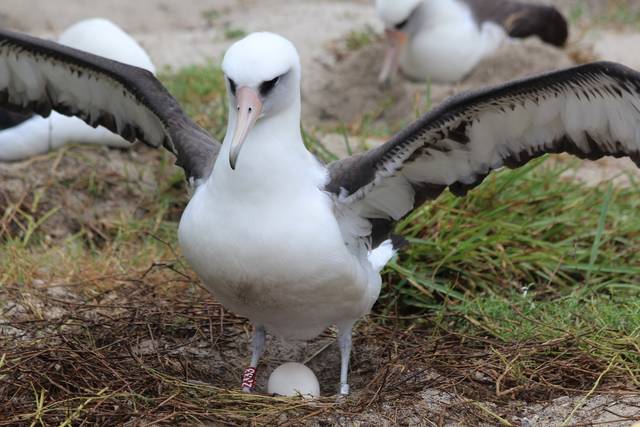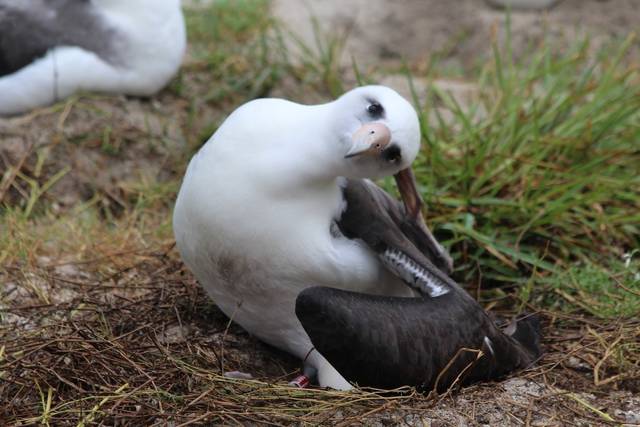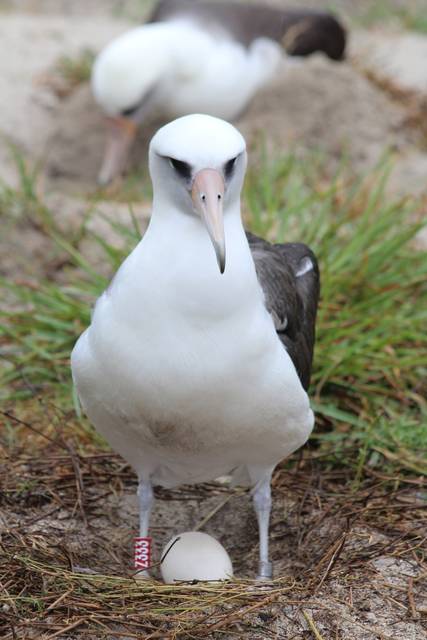Albatross arrivals



LIHUE — The world’s oldest known banded wild bird is sitting on a brand new egg in Papahanaumokuakea Marine National Monument.
Wisdom, a Laysan albatross estimated to be at least 68 years old, has been returning nearly every year to Midway Atoll all of her breeding life. She was first spotted at her nest site on Nov. 29 this year.
The egg comes a bit earlier than in the 2017 season, when biologists spotted Wisdom and her mate Akeakamai at their nesting site in late November and confirmed the pair with an egg on Dec. 13, 2017.
That chick died before it could fledge, one of the 25 percent that don’t successfully fledge and leave the colony, according to the U.S. Fish and Wildlife Service.
Wisdom has raised more than 35 chicks in her lifetime. All of those, true to albatross form, return to their natal nests to breed starting about the age of 5.
During nesting season, juvenile albatross can be found all over Midway Atoll, practicing elaborate courtship dances that involves dozens of ritualized movements. Once a pair bond forms, they stay bonded for life.
“If you can imagine when Wisdom returns home, she is likely surrounded by what were once her chicks and potentially their chicks. What a family reunion!” said Kelly Goodale, USFWS refuge biologist. “Midway Atoll’s habitat doesn’t just contain millions of birds, it contains countless generations and families of albatrosses.”
Nearly 70 percent of the world’s Laysan albatross and almost 40 percent of black-footed albatross, as well as endangered short-tailed albatross and 20 other different bird species, all rely on Midway Atoll.
Restoration of native habitat and other conservation measures have helped ensure these birds are able to return.
“Laysan albatross and other seabirds depend on the habitat protected by Midway Atoll and other Pacific remote wildlife refuges to raise their young,” said Bob Peyton, Midway Atoll National Wildlife Refuge and Battle of Midway National Memorial project leader.
But Wisdom, Akeakamai and the rest of the albatross returning to Midway aren’t the only seabirds migrating back to solid ground. Many of them have already returned to Kauai as well.
Jennifer Waipa from Kilauea Point National Wildlife Refuge reported the first of the albatross landing around Nov. 13.
That week there were also reports of albatross in Princeville and the Kilauea area.
“Right now, lots of known nesters are back and eggs are already on the ground,” said Kim Rogers of Kauai Albatross Network. “We still expect more pairs and more nests.”
Throughout November, the Kauai Albatross Network has been documenting the arrival of Kauai’s birds, like a pair nicknamed Click (KP338) and Clack (KP643) documented reconnecting in a Princeville yard on Nov. 27.
“Each year, Click and Clack spend their first day together moving between three or four favorite spots around the yard,” Kauai Albatross Network reports on their website, next to a video of the birds.
A few days later, Mahealani also returned, the albatross who lost her mate Pilialoha to a long-line fishing hook in 2016. The albatross returned to their nesting site in 2017 and stayed there alone before returning to sea after a few days.
This year, she returned to the site and was skittish for a few days until around Nov. 30, when Kauai Albatross Network reported she was “allowing proximity of other birds.”
“This may bode well for her prospects of a new partner,” Kauai Albatross Network staff said.
The season is just picking up as albatross return to their nesting sites either to reunite with their life-long partners, or to socialize with other singles and find a mate.
Rogers reminds everyone that albatross are fiercely protective of their nests and won’t leave if predators threaten the chick — and predators can be people’s pets.
“They won’t leave (the nest), not even if a dog or cat is threatening, so it’s super important to keep pets leashed or contained,” Rogers said.
